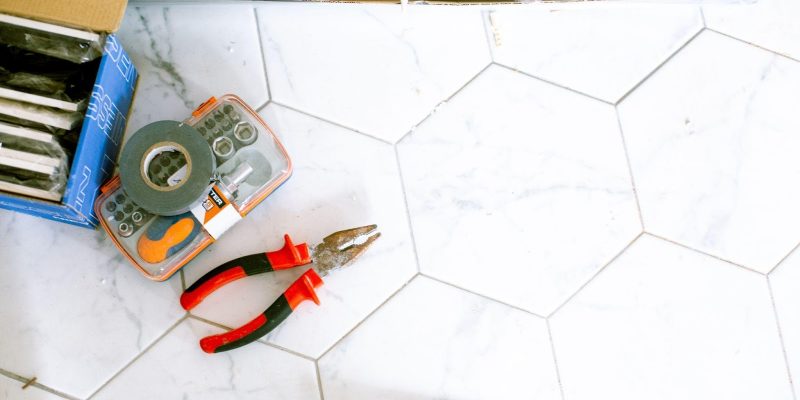The rise of DIY culture has found its way to home improvement, attributable to the ease of access to home improvement resources and tutorials, the prohibitive costs of hiring contractors, and the desire to take complete creative control over the space of one’s home. Whether you’re a novice trying to complete a simple task like painting a wall, or an expert looking towards renovating their house, a took-kit filled with all the essentials is crucial to the ease with which you can accomplish your goals and ensures your safety.
While those passionate about the craft may desire something more extensive, these seven tools represent the fundamentals needed for any home improvement project.
1. Tape-Measure
It is an absolute must-have within any toolkit. Having the ability to measure distances accurately is essential for all kinds of home improvement activities. It is helpful for simple tasks like hanging artwork or installing furniture, where a tape measure can give you an idea of the exact dimensions of whatever you bring into your home so that you can plan accordingly. It is also essential for more complex home improvement work, like renovation, where accurate measurement is crucial for creating a layout to map your renovation plans.
When buying a tape measure, search for something that extends at least 25 feet, so it’s useful for a wide range of measurements. Ensure that whatever you buy has a good build quality, a reliable locking mechanism, and is easy to use and hold.
2. Saw
Saws are valuable tools for home improvement activities that cut through different kinds of material, like wood, plastics, and metals, so you can resize them to meet your specific home improvement needs. Online resources like diytooladvisor.com can guide you in determining the kind of tools needed for your home improvement tasks and help identify the best product available at your specific price point. Tutorials on websites like Youtube can help you learn how to safely operate this machinery, including advice on securing the material you are cutting, determining which blade to use, and handling the saw.
Mastering your sawing skills helps enable a greater degree of customization within home improvement projects. You can trim or even redesign furniture to make it better suited to your space’s aesthetic.
3. Screwdrivers
Screwdrivers are the most common tool found in any house. Their usefulness is not limited to just home improvement and can prove functional in handling any item or product held together by screws(and there are many). For your home improvement tasks, their use comes in assembling and disassembling furniture like drawers, cabinets, beds, tables, etc.
When purchasing screwdrivers, make sure you have something for the various kinds of screws. You will need a flathead, a Phillips, and a Robertson. In addition, ensure you have different sizes of screwdrivers so you can effectively handle both large and small screws.
4. Hammer
Archeological evidence suggests that the hammer might be the oldest tool known to human civilization. Despite its prehistoric origins, it remains an indispensable tool in home improvement. Outside its primary purpose of hammering and removing nails, hammers are useful for adjustment and alignment, like slightly altering the frame of a door to ensure a more proper fit. They are also functional for demolition, including breaking down old walls or floor tiles.
When purchasing a hammer, ensure whatever you get is comfortable for you to use, do not buy a hammer you find too heavy or cannot grip, for this poses dangers in use. Also, consider the tasks you will be undertaking and the materials you are handling. Lightweight hammers are better for more delicate tasks like adjustment, while heavier hammers are more functional in demolition.
5. Level
A level is a tool that tells whether an object is perfectly horizontal or vertical. It is a useful tool for everyday home improvement tasks and more complex and intricate home improvement projects. For work around the home, a level is vital for installing cabinets and countertops to prevent uneven surfaces.
For more structural tasks, levels play a vital role in ensuring structural integrity, whether constructing a wall, laying foundations, or installing a beam. Level structures allow for efficient weight distribution that prevents the build-up of stress within any part of the structure and can eventually cause its collapse.
6. Safety Gear
Even the simplest home improvement tasks require us to take precautions for our safety and good health. While the kind of safety gear you need depends on the project you are undertaking, there is protective gear that any home improvement enthusiast should own. These include safety goggles and masks to protect you from flying debris and dust, ear muffs if you are going to be around loud machinery, and a proper set of work gloves to protect your hands from the tools you are using.
Not being diligent about your safety while working on your house can expose you to many dangers. Further, it undermines the cost-cutting aspect of making this activity DIY, as the hospital bills you will be dealing with will be just as substantial, if not more, than whatever a contractor might have charged you.
7. Tool-Box
Once you have completed your collection of tools, you need a way to store them that makes them easily accessible, mobile, and where they do not take up unnecessary space. Sifting through an array of uncoordinated tools while working on complex and time-sensitive home improvement tasks can be arduous. It eliminates a lot of the fun and joy of the activity and makes you considerably less efficient. Having a tidy workspace and the ability to find the exact tool you need as soon as you need it will improve your DIY home improvement experience.
When buying a tool-box, consider something with multiple compartments, which can store different categories of tools, making them even easier to find.
Conclusion
We live in an age where you can buy the resources for home improvement activities online and learn the skills required to undergo these processes from within the comfort of your home. No longer are the contractor’s exorbitant fees a barrier preventing you from having the home of your dreams. All it takes is a little initiative and the willingness to dedicate time to learning a new task.




















